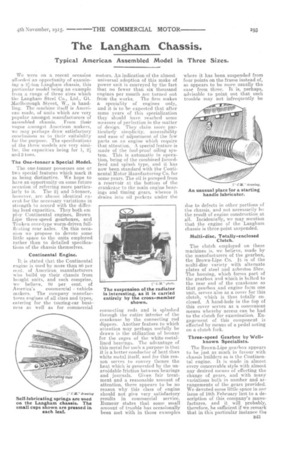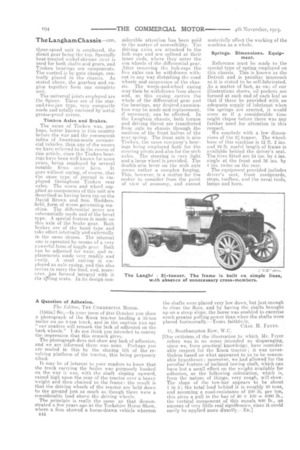The Langharn Chassis.
Page 13

Page 14

If you've noticed an error in this article please click here to report it so we can fix it.
Typical American Assembled Model in Three Sizes.
We were on a recent occasion afforded an opportunity of examining a 4-ton Langharn chassis, this particular model being an example from a range of three sizes which the Langhain Steel Co., Ltd., Gt. Marlborough Street, W., is handling. The machine itself is American made, of units which are very popular amongst manufacturers of assembled chassis. From their vogue amongst American makers, we may perhaps draw satisfactory conclusions as to their suitability for the purpose. The specifications of the three models are very similar, the capacities being for 1, 2A and 3 tons.
The One-tonner a SpecialModel.
The one-tonner possesses one or two special features which mark it as being distinctive. We hope to have an opportunity on some future occasion of referring more particu
larly to it. The :1,7 and 3-tonner, however, are almost identical except for the necessary variations in strength to accord with the differ. ing load capacities. They both ern. .ploy Continental engines, Brown. Line three-speed gearboxes, and Timken aver-type worm-driven, fullfloating rear axles. On this occasion we propose to devote some little space to the units employed rather than to detailed specifications of the chassis themselves.
Continental Engine.
It is stated that the Continental engine is used by more than 80 per cent. of American manufacturers who build up their chassis from bought units, and such comprise, we believe, 90 per cent. of
America's commercial vehicle makers. The company manufactures engines of all sizes and types, catering for the touring-car business as well as for commercial motors. An indication of the almost universal adoption of this make of power unit is conveyed by the fact that no fewer than six thousand engines per month are turned out from the works. The firm makes • a. speciality of engines only, and it is to be expected that after some years of this specialization they should have reached some measure of perfection in the matter of design. They claim more particularly em mph city, accessibility and ease of adjustment of the few parts on an engine which require that attention. A special feature is made of the fool-proof oiling system. This is automatic in operation, being of the combined forcedfeed and splash type, and it has now been standard with the Continental Motor Manufacturing Co. for some years. The oil is pumped from a reservoir at the bottom of the crankcase to the main engine bearings and timing gears, whence it drains into oil pockets under the
connecting rods and is splashed through the entire interior of the crankcase by the connecting rod dippers. Another feature to which attention may perhaps usefully be drawn is the utilization of bronze for the cages of the white-metallined bearings. The advantage of this metal for such a purpose is that it is a better conductor of heat than white metal itself, and for this reason serves to convey thence the heat which is generated by the unavoidable friction between bearings and journals. Given fair treatment and a reasonable amount of attention, there appears to be no reason why this class of engine should not give very •satisfactory results in commercial service. Rumour states that some small amount of trouble has occasionally been met with in those examples
where it has been suspended from four points on the frame instead of, as appears to be more usually the casg from three. It is, perhaps, advisable to point out that such trouble may not infrequently be due to defects in other portions of the chassis, and not necessarily be the result of engine construction at all. Incidentally, we may mention that the engine of the Langliani chassis is three-point suspended.
Multi-disc, Totally-enclosed Clutch.
The clutch employed on these machines is, we believe, made by the manufacturers of the gearbox, the Brown-Lipe Co. It is of the multi. disc variety with alternate plates of steel and asbestos fibre. The housing, which forms part of the gearbox and which is belted to the rear end of the crankcase so that gearbox and engine form one unit, serves also as a cover for this clutch, which is thus totally enclosed. A hand-hole in the top of this cover serves as a convenient means whereby access can be had to the clutch for examination. Engagement of this component is effected by means of a pedal acting on a clutch fork.
Three-speed Gearbox by Wellknown Specialists.
The Brown-Lipe gearbox appears to be just as much in favour with chassis builders as is the Continental engine. It is made in almost every conceivable style with almost any desired means of effecting the change of gears, and with many variations both in number and arrangements of the gears provided, We devoted some little -space in our issue of 18th February last to a de.scription of this company's manufactures, and it will probably, therefore, be .sufficient if we remark that in this particular instance the
three-speed unit is employed, the direct gear being the top. Specially heat-treated nickel-chrome steel is used for both shafts and gears, and Timken bearings are components. The control is by gate change, centrally placed in the chassis. As stated above, the gearbox and engine together form one complete unit, The universal joints employed are the Spicer. These are of the starand-two-jaw type, very compactly made and totally enclosed by metal grease-proof covers.
Timken Axles and Brakes.
The name of Timken was, perhaps, better known in this country before the war and the consequent influx of American-made commercial vehicles, than any of the names we have referred to in the course of this article, since the Timken bearings have been well known for some years, being employed by several notable firms over here. It goes without saying, of course, that the same type of journal is employed throughout Timken rear axles. The worm and wheel supplied as components of this unit are described as having been cut on the David 'Brown and Son, Huddersfield, form of worm generating machine. The differential gears are substantially made and of the bevel type. A special feature is made on this axle of the brake gear. Both brakes are of the band type and take effect internally and externally in the same drums. The internal one is operated by means of a very powerful form or toggle gear. Both can be adjusted for wear, and replacements made very readily and easily. A steel casting is employed as axle casing, and this also serves to carry the load, and, moreover. „has formed integral with it the Srrhrig seats. In its design con siderable attention has been paid to the matter of accessibility. The driving axles are attached to the hub caps and are splined at their inner ends, where they enter the sun wheels of the differential gear. After removing the hub-caps the live axles can be withdrawn without in any way disturbing the road wheels and suspension of the chassis. The worm-and-wheel casing may then be withdrawn from above and, as this casing carries the whole of the differential gear and the bearings, any desired examination may be made and replacement, if necessary, can be effected. In the Langham chassis, both torque and driving thrust are transferred from axle to chassis through the medium of the front halves of the rear spring. The front axle is also Timken, the same company's bearings being employed both for the steering pivots and also for the stub axles. The steering is very light and a large wheel is provided. The double-arm lever on the stub axle seems rather a complex forging. This, however, is a matter for the maker to consider from the point of view of economy, and cannot
materially affect the working GI the machine as a whole.
Springs. Dimensions. Equip ment.
Reference must be made to the special type of spring employed on this chassis. This is known as the Detroit and is peculiar inasmuch as it is stated to be self-lubricated. As a matter of fact, as ono of our illustrations shows, oil pockets are formed at each end of each leaf so that if these be provided with an adequate supply of lubricant when the springs are erected, it would seem as if a considerable time might elapse before there was any further need for attention in this respect, We conclude with a few dimensions of the 21-tonner. The wheelbase of this machine is 12 ft. 2 ins. and 10 ft. useful length of frame is available behind the driver's seat. The tires fitted are 34 ins. by 4 ins. single at the front and 36 ins. by 4 ins, twins on the rear.
The equipment provided includes driver's seat, front mudguards, steps, toolbox, and the usual tools, lamps and horn.




















